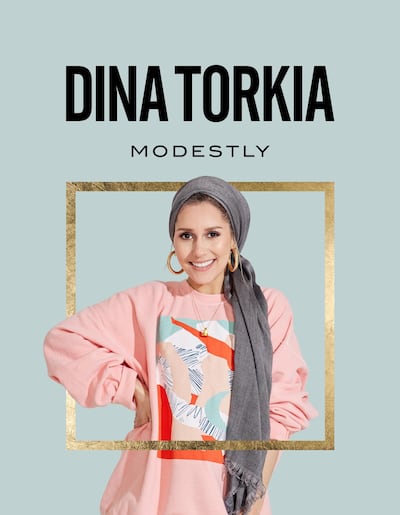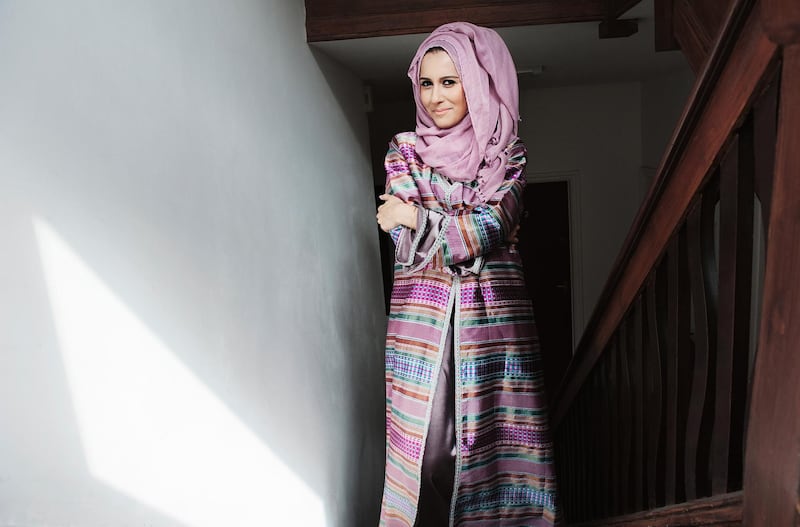Almost 10 years ago, a 19-year-old fashion-mad Muslim girl growing up in Cardiff, Wales, and working in a call centre (having dropped out of three university courses), bought a sewing machine and started blogging.
“I was frustrated by the lack of clothing options out there on the high street for women like me,” says social media star Dina Torkia. “Blogging in general is new, and it’s even newer for women with headscarves.”
Torkia went public on Facebook offering styling tips and ideas, accruing such a following that she was persuaded by her audience to move on to YouTube and make videos about cool ways to wear the hijab. This has since grown into a website and Instagram account that has earned her a global following of 2.4 million. Now she is courted by big brands such as Tom Ford, YSL Beauty, Revlon and H&M, while her turban tutorial with Liberty has been watched 3.4 million times.
Stylish and engaging, Torkia is an entirely relatable personality, talking about subjects ranging from fashion to marriage and family, but also more controversial issues. And now she's written a book, Modestly. A guide to love, life and modest style, it presents the story of her life in a frank and funny way, along with all the requisite skincare routines and features on finding the right accessories that you would expect to find in a blogger's memoir.
“I do a lot of blogs with my husband on YouTube, talking about the important things in life that go a bit deeper than how to wear jeans,” she quips over the phone from Caerphilly, where she lives with her husband, Sid, three-year-old toddler, Hana, and eight-week-old baby boy, Mika. The new baby has her housebound for the moment, just as her book is being published. “I knew this was going to happen,” she admits ruefully about the timing.

Completely self-taught, Torkia began by making the sorts of clothes she always dreamt of and modelling her creations on social media. She shared her fashion highs and lows, tips on how to adapt purchases from high-street chain stores or hunt down lesser-known designers. Beauty tutorials followed, but it was her “million ways of wearing a hijab” that really engaged her followers in the early days. As a blogger, Torkia’s hijab was her unique selling point. “It was almost impossible to find one that matched the rest of my clothes. Options were limited to tacky headscarves from Islamic shops or high-end designer creations from Louis Vuitton or DKNY with too little fabric,” she says.
Ups and downs in her relationship with the hijab
She has had plenty of ups and downs in her relationship with her hijab – a daily commitment for 20 years. “It can be tough. If you think being a young woman in today’s society is hard,” she says speaking of growing up in Britain, “then try being a young Muslim girl in a hijab; there’s no hiding away on a bad day for us. I give props to Muslim girls and women, especially those who are having a hard time wearing the hijab, but are still committed to it.”
Born to an Egyptian father and British mother, Torkia and her twin sister were born in Cairo and lived there until her family moved to London when she was 6. The blogger’s way of dressing modestly is reflective of the British-Muslim experience, but it took a long time for the tomboy in her to adjust to this new style when she became a teenager. She was bullied but, as she admits in her book: “Boy, was I a loud mouth! I was quick to make a bully look silly.”
Zero tolerance for men who comment on her choices
Maybe that has helped her develop the thick skin needed to handle the negative feedback some of her blogs receive. "The majority are supportive, then there are those men and women who disagree with what I am doing, and think it's damaging for the Muslim youth in Britain," she says.
She has zero tolerance for men who comment on the way she wears her headscarf or the way she chooses to dress, from the safety of their computers at home: “I hate it and think it is completely wrong,” she says. She makes the point that if that is their attitude, then they shouldn’t be looking at photos of her on the internet, anyway. Nevertheless, she doesn’t let criticism consume her and has come to regard these comments from the “haram police” as a source of entertainment.
Torkia’s attitude to wearing the hijab is altering, she admits. She is less judgemental in her attitude towards Muslim women who dress less modestly than her, and has become increasingly experimental, sometimes wearing a turban instead of a headscarf tied under her chin, and letting a strand of dyed hair slip free. Currently, her dark hair is coloured grey, previously it was pink. “I dye my hair all the time. I love crazy colours.”
The problem with 'token diversity'
As one of the first Muslim bloggers in Britain – the only other Muslim fashion blog was Pearl Daisy by Amena Khan – Torkia was approached by fashion and beauty brands, which clamoured to work with her as they became more aware of this growing demographic. But while they get good feedback, they don’t always come back, Torkia admits. She wonders whether this is because it is token diversity, but also if some of the religious political commentary she sometimes receives may put them off. “What brands wants to be associated with any kind of controversy?” she says. “But if a brand wants to be diverse and inclusive, then they have to be ready to hear us as well as see us.”
She admits that as a Muslim woman, it is not easy to put yourself out there. There are very few Muslim role models. “If you don’t see anybody in the media, you automatically have no aspiration to be in that field. Whereas now, you have models like Halima Aden and there are young girls thinking: ‘She looks like me’, and automatically they want to be a model,” says Torkia.
As a full-time blogger, Torkia has travelled to Indonesia, where she was mobbed by her followers and Dubai, where she attended Dubai Modest Fashion Week and did a blog collaboration with Dubai’s tourism board. “I keep being told to come to Dubai as there is so much work for bloggers, and there is a truth in that. The Dubai blogging world is very much business, whereas the United Kingdom can feel more like a rat race,” she admits.
Nevertheless, she will be 30 next year and admits that she cannot be “this personality” forever, so is starting to think about what comes next. In the early days, she had a scarf and nascent clothing line, so she may resurrect that. “Maybe I will be a business woman sharing my creative work again, rather than sharing my life.”
Modestly by Dina Torkia is expected to be published this week by Ebury Press






